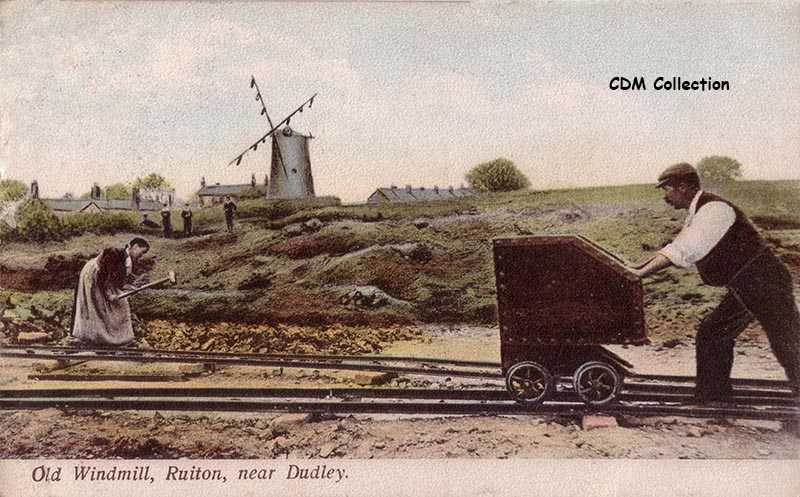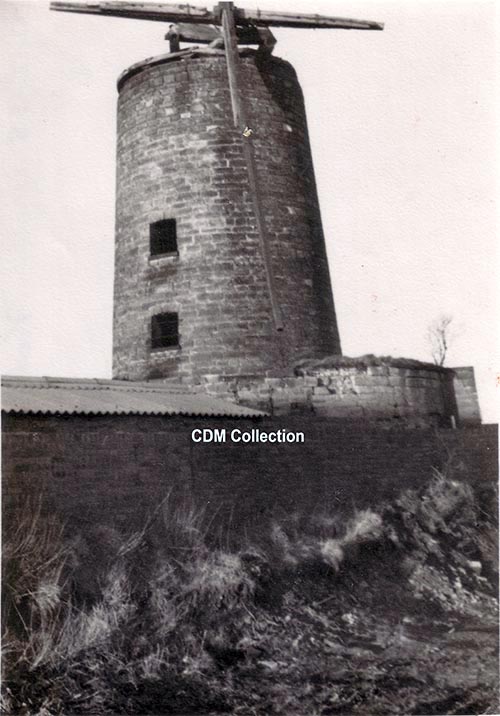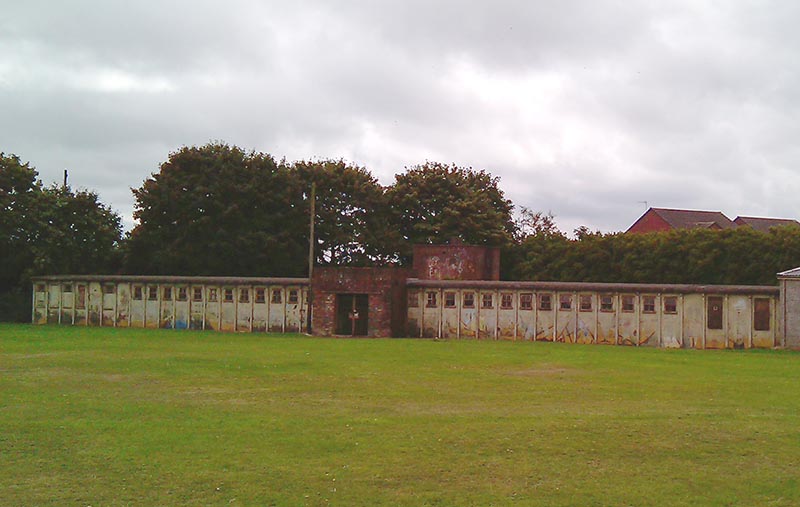
|

|
|||||||
|
Landmarks ~
Churches ~
Pubs ~
Shops ~
Amenities ~
Dwellings ~
Events ~
Schools ~
Sports
Industrial ~ Transport ~ Folklore ~ Families
Gallery ~ Landmarks
The Ruiton Mill
 Ruiton Windmill around 1900, showing the sails in tatters. Ruiton Windmill around 1900, showing the sails in tatters.
John Price postcard c1905 (CDM Collection).
Off Vale Street, Ruiton, Upper Gornal.
A windmill at Ruiton has existed since the 17th century, the old mill has long since been demolished, a new windmill,
the remains of which still show on the skyline, was built by George Richmond in 1830.
The mills occupied a lofty position well suited to their purpose at Ruiton. Ruiton Mill tower has long since lost its sails, internal workings and grinding stones.
The adjacent mill cottages which included the bake-house were also constructed using the local quarried stone.
Several mills existed at Ruiton in the 19th Century, used for flour and grinding sand.
The Old Rewardine Windmill.
The old windmill at 'Rewardine' [Ruiton] was built of local stone,
it was situated near to the summit of Hill Street, Ruiton.
In the 17th Century, it belonged to local gentry, the Persehouse family.
In 1702, Peter Persehouse sold Rewardine Mill to Thomas Maullin. Among the probate items of Thomas Maullin of "Overgornal" [Upper Gornal] in 1722, were two millstones, 'Barley on the ground', hayricks, 4 cows, pig and mare, plus a large list of workshop and household items, all totalling £73.13.11. [Sedgley Probate Inventories, Roper]
The Old Mill continued in the ownership of the Maullin family and leased to local millers.
In 1759, Job Maullin disposed of it to William Woodward of Bloxwich and John Lees of Walsall. Their ownership lasted only a short time and it was sold to Samuel Fereday of Upper Gornal.
In 1790, Samuel Fereday transferred ownership of the windmill to his Son, Samuel Fereday,
farmer of Park Farm, Sedgley.
1861: Newspaper Sale Notice
Thomas Turner and Benjamin Lloyd took possession in 1795, and in 1805 it was sold to William Richmond.
By 1835, it was in the ownership of his son George Richmond who had just built the new windmill nearby in Vale Street. It was described in Mr. Richmonds bankruptcy notice in 1837 as... "all that other corn wind mill, with a messuage or dwelling-house, store-room, stabling, pump of water and garden..."
After the failure of George Richmond in 1837, it passed to a succession of owners, in the 1844 Tythe,
it was owned by Paul Thompson, described as 2 Houses, Windmill, Yard etc...
The last owner being Edward Jones who took possession in 1861. It is likely that it was used for grinding sand from the local quarries in much of it's later life. However the windmill fell into a dilapidated condition and eventually fell down sometime in 1872 due to age and the proximity of the quarry workings.
A contemporary account of the demise of the Old Mill reads:-
Mr. Edward Jones, the owner, first noticed at 8 o'clock in the
morning that it leaned very much.
He very properly cautioned people living nearby that it would likely fall. About 10 o'clock a terrible rent appeared across the front of the mill and the back part of it had sunk some inches in the ground. A great number of people by this time had collected near to witness the end of Ruiton Old Mill, and great anxiety was felt with regard to the damage that was likely to follow to houses close by, and over which there seemed a sad but inevitable consequence. However all anxiety soon ended, for a few minutes before 12 o'clock it fell without doing damage to any house or person, and much thankfulness was expressed by those living near for such a marvellous escape.
Two further mills were located at Ruiton according to the 1844 Tithe map, they were located near to the Old Mill but
it is thought that these may have been Oxen powered sand crushing mills and not windmills, there would have been sand
crushing mills at the stone quarries.
Piece 2515, described as House, Land, Mill & Land, owned by Isaac Williams and occupied by Aaron Hall, The other mill, piece 2534, is described as a Sand Mill occupied by Esther Rollason.
The New Windmill at Ruiton
George Richmond, who owner of the old mill, had built the new windmill in 1830.
1837: Notice on the bankruptcy of George Richmond.
The 'new' windmill was substantially built of sandstone from the nearby quarry,
it had three grinding stones capable of grinding 120 bags of corn per week.
The new venture by George Richmond was short-lived and he was bankrupted in 1837 and both mills were sold off.
George Richmond was described as a Miller, Baker, Dealer and Chapman in bankruptcy notices in 1837.
Robson's 1839 directory lists him as a Pawnbroker, Upper Gornal.
The 1844 Tythe map shows the new mill was owned by Holyoak & Co., the plot was described as a House, Mill, Garden & Croft.
In the last few years of it's active life, the 'new' mill was possibly used to grind sand
from the nearby stone quarry after the old mill had fallen, the resulting fine sand was
extensively used around the area for scouring.
1860: Aris's Birmingham Gazette, October 13.
1864: Newspaper Notice.
 Location of the old and new Windmills, at this time belonging to Paul Thompson, the 'Sand Mill' may have
been Oxen powered.
Location of the old and new Windmills, at this time belonging to Paul Thompson, the 'Sand Mill' may have
been Oxen powered.
The last recorded use was in the 1870s, in 1877 a storm hit Ruiton and it was reported
that the sails were damaged.
A newspaper of December 1877, reported violent gales accompanying bad snow storms had affected Ruiton and damaged several buildings in the area. "..the sails of Ruiton Windmill which is used for grinding sand, were destroyed". It is likely that it was no longer used for grinding after that time.
The new mill at Ruiton apparently didn't prosper under any ownership, no doubt
partly due to the changing landscape of the area -the once farmland yielding to quarrying and mining enterprises.
The Mill fell into a poor state of repair and was derelict for a long period of time. During the 1950s there was more interest in saving this landmark.  Ruiton New Mill as photographed by local historian E.A. Underhill c1912. Ruiton New Mill as photographed by local historian E.A. Underhill c1912.
This scene was later published in Underhill's book of poems 'Patchwork', and also part of a series of postcards.
The four spars - the wooden remains of the sails, were removed in the late 1950s after a very long period of disuse
and decay.
The windmill became a grade II listed building in 1950, although throughout
that decade its future was in still in doubt, the preservation of the windmill
tower was taken over by the local authority.
The nearby stone cottages are also listed buildings and of the same period as the tower. The Mill Cottages are now a private residence.
In 1958, Staffordshire County Council acquired the Mill from quarry-master William Rollason,
who's family had possessed the Mill for the previous 50 years.
The condition of the Mill at this time was poor, the sails were only a bare skeleton, the main shaft inside had fallen and one of the two gritstones was broken. There were still remains of the cog wheel and crown wheel, the cog made of iron -the teeth of which were of oak tapped in with a retaining wedge. The sails and gearing were removed and put into storage, then work commenced on capping the mill with a concrete crown, fitting three floors with connecting wooden stairs, then when the project initiated by Staffordshire County Council was complete in 1962, the mill was offered for use by local scout groups.
The Mill is now used as the headquarters for the Dudley Caving Club, who use the structure for
abseiling, and also Dudley Amateur Radio Club who regularly meet there as well as local youth groups.
Internally, it has been refurbished and has toilet and kitchen facilities, it occupies three floors,
as well as the roof which gives impressive views on a clear day over Shropshire, Staffordshire, Worcestershire, West Midlands and beyond.
 Remains of the windmill can be seen on virtually every horizon in the area. Remains of the windmill can be seen on virtually every horizon in the area.
Photo CDM 2015
 Showing the courtyard and entrance. Showing the courtyard and entrance.
Photo CDM 2017
 Fabulous views to the west
showing Titterstone Clee Hill (left) and Brown Clee (right)
on the horizon more than 20 miles away.
Fabulous views to the west
showing Titterstone Clee Hill (left) and Brown Clee (right)
on the horizon more than 20 miles away.
Photo CDM 2017.
Standing around 900 feet above sea level, the top gallery of the mill gives outstanding views in all directions but particularly to the south and west,
where on a clear day the horizon 40 miles way can be seen.
 Mill Cottages with the remains of the old windmill towering in the background. Mill Cottages with the remains of the old windmill towering in the background.
Photo CDM 2014
~
|
|


 Two photos of Ruiton windmill in 1958.
Two photos of Ruiton windmill in 1958.
 The spars and gears were removed shortly after.
The spars and gears were removed shortly after.

 Shops
Shops Pubs
Pubs